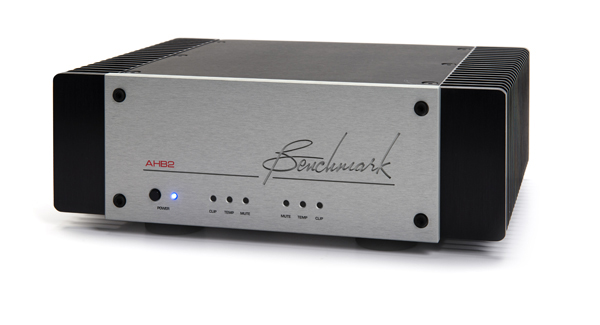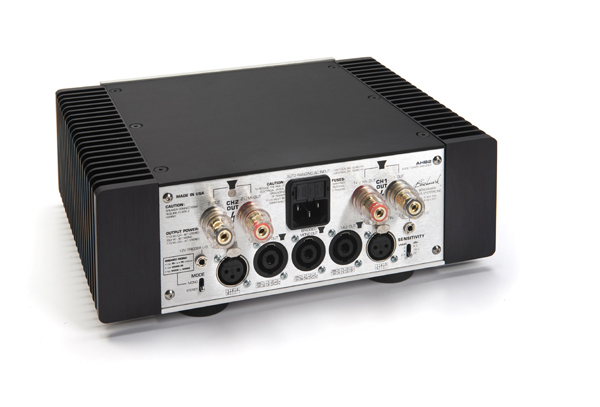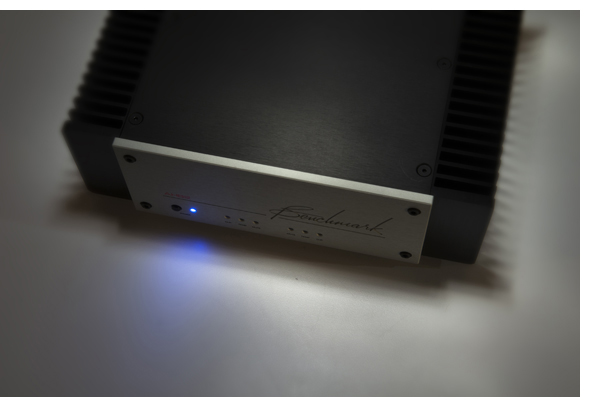Benchmark AHB2 Power Amplifier Tiny But Tough
By Rob Johnson
 The first thing you notice about the new Benchmark AHB2 is its diminutive size. Even with feet and binding posts, it’s only about 11 inches wide, 4 inches tall and 9 inches deep. And the heat-sink fins account for about a third of that width, making it even more incredible that Benchmark was able to jam so much oomph into such a small body. Regularly lifting amps that leave my back barking for Tylenol, I chuckle with relief when carrying the 12.5-pound AHB2 to my audio rack.
The first thing you notice about the new Benchmark AHB2 is its diminutive size. Even with feet and binding posts, it’s only about 11 inches wide, 4 inches tall and 9 inches deep. And the heat-sink fins account for about a third of that width, making it even more incredible that Benchmark was able to jam so much oomph into such a small body. Regularly lifting amps that leave my back barking for Tylenol, I chuckle with relief when carrying the 12.5-pound AHB2 to my audio rack.
At about $3,000, the Benchmark AHB2 is a substantial investment, and it certainly demonstrates many musical characteristics one would expect at this price point. But the amp’s size makes it appealing when shelf space is limited or when you simply want to minimize your gear real estate. If more power is desired, you can buy a second AHB2 and configure them as monoblocks.
Benchmark offers the unit with a black or silver anodized faceplate and black heat-sink fins. A studio version is also available, with a wider front plate to fit equipment racks. Other than its tiny power button, the front of the amp has no other controls, just a few LEDs to indicate aspects of operation. Each channel has three LEDs to indicate clip, temperature and mute. In the event of an amp overload (which happened once during my testing), the amp shuts itself down and the LEDs indicate the nature of the problem. Powering the unit off, waiting a few seconds and pressing the power button puts the amp back into operational mode.
Setting the Benchmark
As Benchmark products are used regularly in recording studios, all of the AHB2’s connections are balanced. A couple audio designers have explained to me that balanced XLR connections usually prove superior to single-ended RCAs, since XLRs offer inherent noise canceling and they won’t come loose once clicked into place. If the rest of you’re system doesn’t offer XLR connections, Benchmark also makes cables and adapters.
Setup is fairly straightforward: Connect a preamp and speakers, ensure the stereo/mono toggle is set to the desired position, and then set the three-position sensitivity switch to match the signal levels from your preamplifier; the sensitivity switch also optimizes the amplifier’s gain for controlling volume from your preamplifier. Because of the amp’s size, its back panel can get crowed, making connections a little tricky—especially with my speaker cables, which have soldered spade connections that don’t bend. As such, I have to place the amp at the back edge of my audio shelf so the cables can hang below the amp (though I’ve had this same problem with other amps I’ve tested).
The AHB2 also offers twist-lock NL4 ports for speaker connection. Benchmark says NL4s provide lower resistance and higher current handling than connection via binding posts, as well as a more secure connection. As most speakers don’t have an NL4 connection option, Benchmark makes speaker cables with NL4 connectors for the amp side and standard connections for the speaker side.
Once everything is connected, simply push the power button on the front panel to activate the start-up sequence. When configured as a stereo amp, the AHB2 pushes out 100 watts into 8 ohms and double that into 4 ohms. For those wanting a 12-volt trigger for remote power-up, the AHB2 has you covered.
The AHB2 features a Class-AB/Class-H design (hence its name), which facilitates bridging a pair of the amps to use as monoblocks, pushing 380 watts into 8 ohms. This scenario is very useful if your speakers need some extra juice and you want to provide a dedicated amp for each, or if you want to drive a center-channel speaker in a home-theater setup. When using this setup method, consult the manual to ensure the proper connections and settings.
 Meeting the Benchmark
Meeting the Benchmark
Among Benchmark’s design goals for the amp were extremely low distortion and quiet operation. From the get-go, the amp lives up to its design specs by providing a very clean presentation. The Benchmark does a good job of layering vocals and instruments in all dimensions, with each element supported by a solid and convincing image. The amp’s designer, John Siau, is quick to mention that the third goal was to achieve a ruler-flat high-frequency response—and the AHB2 is completely flat all the way up to 200 kHz. Siau says these qualities are vitally important in delivering high-resolution performance.
As desired in a studio setting, the sonics from the AHB2 are neutral, and in my home setup, there is no observable emphasis in any particular frequency range. I would not characterize the AHB2 sound as warm or romantic, though it’s not stark or emotionless either. Between these two ends of the spectrum, the amp leans toward the latter but with a sweeter top end. Those seeking an amp that emphasizes fullness and richness that will augment slightly thin sound from your preamp or source might consider other amp options. But if accurate portrayal is a listener’s goal, this Benchmark does the trick.
When reproducing poor-quality recordings, the AHB2 does a nice job of limiting digital glare. Lucinda Williams’s album Car Wheels on a Gravel Road demonstrates the AHB2’s ability to offer edge-free portrayal of vocals with a very fluid midrange. Her voice resides upfront in the soundstage and it is well separated from the instruments accompanying her.
Regardless of music type, bass through the Benchmark offers a taught presentation with the snap and punch one expects from percussion. Depeche Mode’s “Personal Jesus” is engaging through the AHB2, with all the subtle synthesized sounds popping into position in the soundstage. This makes me curious about running a pair of the amps as monoblocks—which still wouldn’t take up the rack space of a single traditional amplifier.
The Benchmark brings to life the voice of the Martin Logan Motion XT35 bookshelf speakers. Considering its recording-studio applications, it makes a lot of sense that this amp pairs well with smaller stereo monitors. Combined with the speakers I have on hand for testing, the AHB2’s sound flavor profile remains consistent.
In the case of the AHB2, system synergy is an important factor to consider, since no amp is universally perfect for all speakers. For large and demanding speakers, a prospective AHB2 owner may need more power. In the case of the AHB2, you can add another unit and configure the two amps as monoblocks.

Additional Listening
By Jeff Dorgay
I was curious to hear how Benchmark’s design ethos of compact products would translate into designing a power amp. A couple years ago, the Devialet shattered my bias that amplifiers had to be massive to sound good, and so today I find myself much more open-minded to smaller amps like the Benchmark.
My initial exposure to the AHB2 was at this year’s Rocky Mountain Audio Fest, where Benchmark was playing the amp in an all-Benchmark system that included its new mini-monitor speakers. Back in my own listening rooms, the AHB2 did a fantastic job driving the KEF Blades, Dynaudio Evidence Platinums and even my Acoustat 2+2s, which are notoriously tough to drive, though a pair of AHB2s would have been even better for the 2+2s.
As both my reference systems are balanced, I actually prefer the XLR connections of the AHB2. If you’re working with single-ended RCAs connections, the Cardas adaptors are my favorite. I agree with Rob’s conclusions on tonality, etc., and will add that the AHB2 definitely has the bass drive necessary to achieve convincing full-range performance, even from big speakers.
In the end, the Benchmark AHB2 can become a great anchor to your system, offering high performance in a compact box. With an extremely neutral tonal balance, you can use it straight, or warm it up with a tube preamplifier, should that be your preference. Either way, the AHB2 is a stellar performer from a company known for excellence.
Benchmark AHB2 power amplifier
MSRP: $2,995
PERIPHERALS
Digital Sources
Mac mini, dCS Debussy DAC JRiver Media Center 20 Tidal music service
Analog source
SME 10 turntable with SME 10 tonearm and Dynavector 17D3 cartridge
Amplifier
Burmester 911 MK3
Preamplifier
Coffman Labs G1-A
Speakers
Sonus faber Olympica III, Martin Logan Motion XT35
Cables
Jena Labs
Power
Running Springs Audio Haley power conditioner RSA Mongoose power cords
Accessories
ASC tube traps Mapleshade Samson audio racks



